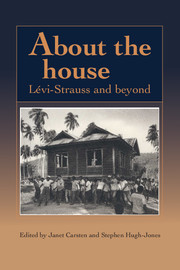Book contents
- Frontmatter
- Contents
- List of illustrations
- List of contributors
- 1 Introduction
- 2 Houses and hierarchies in island Southeast Asia
- 3 The resurrection of the house amongst the Zafimaniry of Madagascar
- 4 The hearth-group, the conjugal couple and the symbolism of the rice meal among the Kelabit of Sarawak
- 5 Houses in Langkawi: stable structures or mobile homes?
- 6 Having your house and eating it: houses and siblings in Ara, South Sulawesi
- 7 The Lio House: building, category, idea, value
- 8 Houses and hierarchy: the view from a South Moluccan society
- 9 Houses, places and people: community and continuity in Guiana
- 10 The houses of the Mẽbengokre (Kayapó) of Central Brazil – a new door to their social organization
- 11 Inside-out and back-to-front: the androgynous house in Northwest Amazonia
- Notes
- Bibliography
- Index
5 - Houses in Langkawi: stable structures or mobile homes?
Published online by Cambridge University Press: 05 June 2012
- Frontmatter
- Contents
- List of illustrations
- List of contributors
- 1 Introduction
- 2 Houses and hierarchies in island Southeast Asia
- 3 The resurrection of the house amongst the Zafimaniry of Madagascar
- 4 The hearth-group, the conjugal couple and the symbolism of the rice meal among the Kelabit of Sarawak
- 5 Houses in Langkawi: stable structures or mobile homes?
- 6 Having your house and eating it: houses and siblings in Ara, South Sulawesi
- 7 The Lio House: building, category, idea, value
- 8 Houses and hierarchy: the view from a South Moluccan society
- 9 Houses, places and people: community and continuity in Guiana
- 10 The houses of the Mẽbengokre (Kayapó) of Central Brazil – a new door to their social organization
- 11 Inside-out and back-to-front: the androgynous house in Northwest Amazonia
- Notes
- Bibliography
- Index
Summary
This chapter examines the applicability of Lévi-Strauss's (1983a; 1983b; 1987) concept of ‘sociétés à maison’, house-based societies, to a Malay fishing village on the island of Langkawi, Malaysia. While it takes its inspiration from the ideas advanced by Lévi-Strauss, it is also the product of dissatisfaction with a preliminary discussion of these ideas (Carsten 1987a), and of the stimulation of other writings on this theme.
Lévi-Strauss's argument relates principally to the Kwakiutl numayma, the medieval noble house in Europe, eleventh-century Japan and to certain Indonesian societies. A number of features of these societies are stressed by Lévi-Strauss. Firstly, continuity occurs through descent, that is, downwards in the inheritance of names and property (1983a: 174; 177–9). Second, he draws attention to the hierarchical ordering of the basic units of these societies. When both the houses themselves and members of these units are ordered according to birth order and proximity to a common ancestor, as he apparently considers to be the case in all his examples, marriage implies unequal status, and plays a central role in the ranking system (1983a: 181).
Third, Lévi-Strauss emphasizes how the ‘dialectic of filiation and residence’ (1983a: 180) is a common feature of house-based societies. In other words, dual membership in a group with bilateral descent and in the residential unit creates conflicting obligations. patri-/matrilineal descent, hypergamy/hypogamy, close/distant marriage.
- Type
- Chapter
- Information
- About the HouseLévi-Strauss and Beyond, pp. 105 - 128Publisher: Cambridge University PressPrint publication year: 1995
- 20
- Cited by

